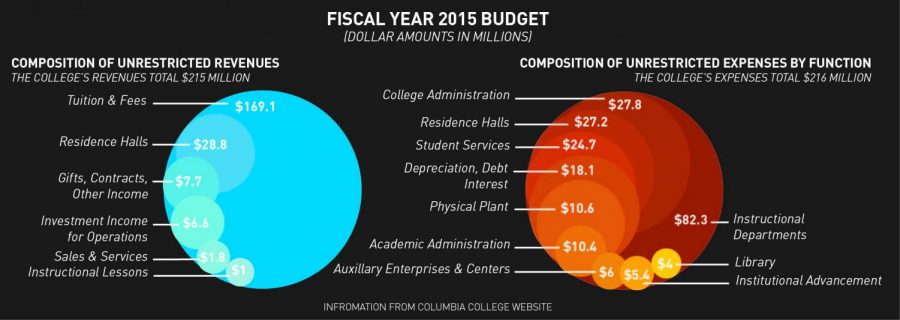Budget transparency goes digital
Budget transparency goes digital
March 30, 2015
Students wondering what their tens of thousands of tuition dollars are doing within the college’s budget can now know with the launch of the college’s new budget web pages.
Developed by Michelle Gates, vice president of Business Affairs and CFO, and the Student Government Association, the web pages provide charts that break down the amount of money that goes into each section of the college’s revenue and expenses.
President and CEO Kwang-Wu Kim unveiled the new web page, hosted on the college’s website, in a March 17 collegewide email outlining the multi-million-dollar budget for the 2014–2015 school year. Designed to inform students where the college is receiving and spending its money, a nearly identical model is also available for faculty and staff.
The site features two charts that detail the college’s estimated revenue and expenses and also reveals where the college planned on receiving and spending millions during the 2014–2015 school year.
Gates said the administration plans to update the site annually to increase budget transparency.
“It tells how much you invest in the students, the instructional department and academic administration, [which] tells you what your overall commitment is in returning resources to the core of educating students,” Gates said.
The college planned to bring in $215 million in revenue, with more than three-fourths coming from tuition and fees. The expenses of the budget were $216.5 million, with more than two-thirds of that going toward expenses in the instructional departments, according to the website.
SGA began working with Richard Dowsek, the college’s former interim CFO, last spring on a plan for budget transparency, said Sara Kalinoski, SGA president and a sophomore art and materials conservation major. They continued their work with Gates after she assumed the position in fall 2014, she said.
Kim said development of the web pages was slow due to high turnover among CFOs—the college has had several CFOs in the last 15 years. They waited until this semester to develop the pages to give Gates time to adjust as CFO.
“Michelle [Gates] is my fourth [CFO] since I’ve been here,” Kim said. “That’s the main reason. It was waiting until we had the permanent [CFO] to develop the materials.”
The administration wanted to be transparent because it is not trying to hide the budget details, Kim said.
“When an institution chooses not to make this information available, there’s always a feeling of ‘Why? Is there something that you don’t want us to know?’” Kim said.
Currently accessible through the college’s website, Kalinoski said SGA and Gates hope to eventually make the page available on OASIS.
“We’re so happy for it to finally be up and running for students to see,” Kalinoski said.
Kim said the web pages will most likely be updated in the summer for the next fiscal year because the budget is set to be approved in May.
Mark Kelly, vice president of Student Success, said SGA has long requested access to knowledge about the college’s budget for students, which sparked discussion about the page’s creation.
“I assume this will be an ongoing conversation and process to help the college community better understand our revenue and expenses,” he said.
Kim said he understands student concerns about budget transparency, which is why this web page is a priority.
“We have an obligation to make the information available for students who are curious and wanting to understand how the place functions more from a business perspective,” Kim said.
Kathleen Siek, a senior audio arts & acoustics major, said having this information available to students is helpful, especially because their tuition dollars fund the college. Tuition counts for $169.1 million of the college’s $215 million unrestricted revenue for the 2015 fiscal year, according to the website.
Siek said students should be informed about the college’s finances, but they may find difficulty understanding the details on the web page regarding how the millions of dollars are divided.
“I don’t know how well the average person would read into it and be able to derive information from it,” Siek said. “It seems like if you’re not already well-versed in revenue and where this stuff goes, you might not understand what [the information] is.”
Kalinoski said she thinks the detail on the site is insightful and easy for students to understand.
“I’m glad they explained each section because maybe not everyone would understand what [they mean], so I think it’s very important that they had that breakdown of where the money is being spent so you could see what each [section of data] represents,” Kalinoski said.
There are long-term benefits to having this information released, Kim said.
“I’m trying to build across the college a culture of accountability,” Kim said. “Accountability starts by first making information available to the community so that if there are questions, they are based on facts and data. When information is not provided, people create their own.”








